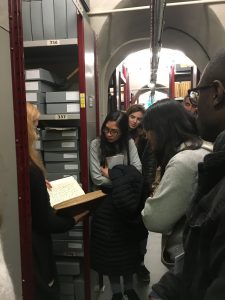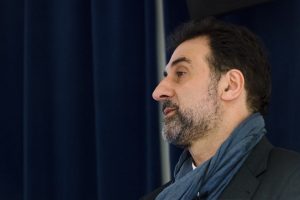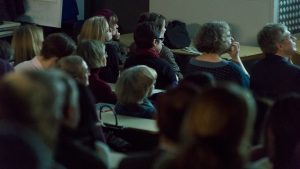As promised, one last post before the end of 2017.
Among the many events of the last two weeks of term were the Staff-Student exchange meetings my colleagues and I have with the student representatives of undergraduate and postgraduate programmes. These are always really interesting and constructive sessions – opportunities for all of you, via your reps, to feedback any issues to us, and for us to respond, and sometimes take away issues for further discussion with the whole department. An example of the rapid working of this mechanism was the discussion about the longer-than-usual Christmas closure of the library and the deadline for MA essays. The reps at the post-grad meeting made an eloquent case for the extension of the deadline, which normally falls on the first day of the Spring term, for an additional week, to 15 January, and we agreed. Democracy in action!
There was also a useful meeting about the British Council Venice Fellowships, in which potential applicants heard from the British Council rep and the two fellows who went to Venice last month. (The deadline for applications is 5pm on 12 January – further information from Clare c.thomas@bbk.ac.uk or Sarah sarah.thomas@bbk.ac.uk) One of this year’s Venice fellows, Ruth Houlsby, MA History of Art with Photography, has written a thoughtful piece for the British Council’s UK at the Venice Biennale blog. Here’s one of her images, showing Yelena Vorobyeva & Viktor Vorobyev’s The Artist is Asleep (1996) – I thought it might resonate with a few of you at the end of term:
Meanwhile here in London, the MA Museum Cultures students were wide awake and out in the field, visiting two highly contrasting archives. Student Richard Godfrey reports:
On the 14th November, we visited both the Bishopsgate institute archive and the British museums archive. Being a totally new experience I didn’t know what to expect. The archive at the Bishopsgate institute was a surprising and humorous visit all thanks to the archive manager Stefan Dickers, who was full off anecdotes regarding his collection. He explained that the archive collects items that are viewed as history from below. The archive does this by collecting from areas like the working class, LGBT community, radical and social history. The reason they collect these items is because often it is this history that is forgotten and the archive acts to preserve them. If you get the chance to visit the archive, then go, even just to listen to Stefan talk about the archives collection or to see their collection of leatherman posters or old take away pizza menus. The British museum’s archive on the other hand was something else altogether, over 200 years of the museum’s history is stored within but in no apparent order. As the Museum is a publicly funded institute its archives are considered to be public records and are available for public access. However the British museum archive is typical of a large institute that is very old – the archive materials have been poorly classified, because in the past the museums interest was mainly focused on its collection. It was interesting to me to see how two archives could be so very different from each other.
An opportunity for the budding young art critics among you (and I say ‘young’ advisedly): the Burlington Magazine has announced this year’s Contemporay Art Writing Prize, with a deadline of 26 February. It’s specifically for aspiring, rather than established, writers, which is good, but it has a maximum age limit of 35, which is bad, and very un-Birkbeck! More here.
Missed Gabriele Finaldi’s Murray lecture on the National Gallery and the Prado, or want to catch it again? Now you can listen here.
I’ll leave you with a seasonal art historical scene, Peter Bruegel the Elder’s Hunters in the Snow (Winter) from 1565 (thanks to Vienna’s Kunsthistorische Museum and the Google Art Project). You never know, we may get more of the white stuff!
. . Category: Uncategorized





